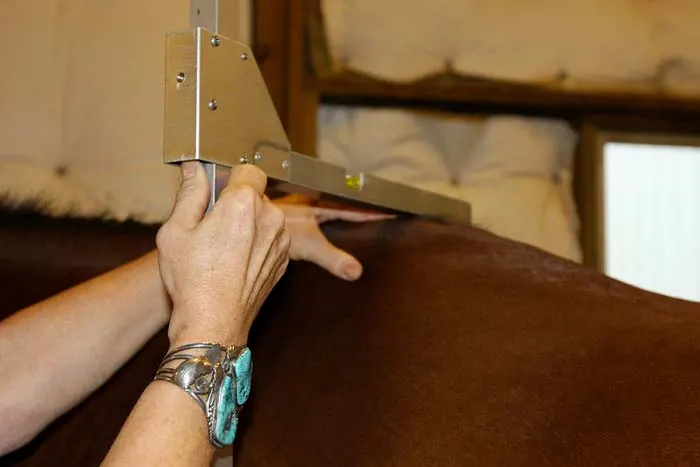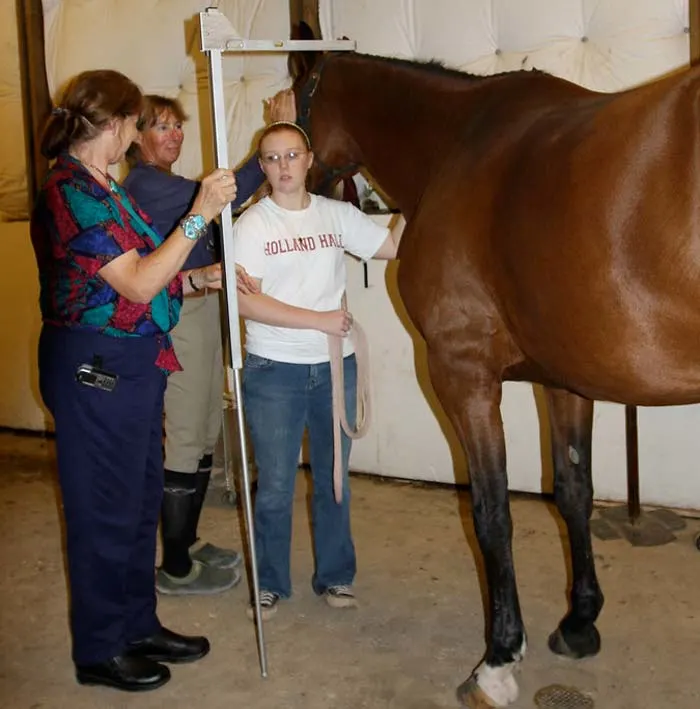For people who haven’t spent much time around horses, understanding horse height can be confusing. Horses are measured in a unique measurement form called hands. Each hand is equivalent to 4 inches.
Descriptions of horse sizes in horse for sale ads, tack catalogs, and other places typically reference a horse’s height by “hands.” To other horse riders this is easily understood, but for many new horse owners or beginner riders, saying a horse is 14 hands, 16 hands, or 18 hands is hard to make sense of!
In this article, you’ll learn more about horse height, how horses are measured, the pros and cons of having a very tall or short horse, and why the heck horses are measured in hands and not feet. You may be surprised what you’ll learn!

First, How Horses are Measured:
Horses are measured in a unit of measurement called a “hand.” A hand is equal to exactly 4 inches.
While a hand is an exact measurement of 4 inches, if you spend enough time around horses you’ll learn that sellers, owners, and breeders like to overestimate a horse’s size. Learn my tip for outsmarting these tall-tales.
The number of hands a horse is describes how tall they stand when they are measured from the ground to the withers- that’s the point where the horse’s neck meets the body with a slight bump at the base of the mane. A horse’s head and neck is never included in height measurements because the position of the horse’s head could dramatically affect the reading!
Why is horse height measured in this unit?
Humans and horses have been partnered for millennia, before rulers and measuring tapes were available or even standardized, there was a need to be able to describe the size of a horse. Handlers, knowing that most human hands were size roughly the same: about 4 inches, begin using the width of the hand is an easy, portable, and somewhat universal way to measure horse height. To measure a horse for sale or for auction they would simply stack hands one on top of another and count how many hands it took to measure the horse from hoof to shoulders.

Rounding Horse Hands Up or Down
The height of a horse is not rounded up or down to the nearest hand. Instead, measurements between whole-hands are represented with decimal points ranging from .1 to .3.
This is somewhat unusual, and not how decimal points are typically calculated. Typically, half of a unit of measurement would be represented as .5, however, with horses it is never correct to describe a horse as “_.5 hands.” Instead, to represent one half of a hand, .2 (representing 2 inches of the 4-inch hand measurement) is used.
Thus, horse heights might be represented as 14.1, 18.2, 12.3, etc, but never 14.5, 15.7, etc.
Here’s a video annotated with some important instructions for getting an accurate horse height measurement:
Is a Hand Measurement Accurate?
Measuring horse height, and especially doing so with an actual hand, is notoriously unreliable. Because human hands do vary in width, in the 20th century it became standard to use a measuring stick that stands straight up from the ground with an extension arm to set on the horse’s withers. You can see an example of this special horse measuring stick below.
This measuring tool helps get a more accurate measurement than using hands or using a soft tape which can give an inaccurate reading due to measuring the contours of a horse’s body.
How to Measure Your Horses Height

How to Measure a Horse’s Height
Be sure your horse is standing on level ground
This ensures the measurement is accurate.
Position your horse so it is standing squarely
If they have one hoof resting, their shoulder might be dropped and give a shorter reading.
Measure from the ground to the withers with a straight stick
Avoid tape, as it will measure curves as height.
Read the stick, or measure with a secondary tape
If your stick doesn’t have measurement markers, add a mark to indicate how high the withers are, then measure to that mark.
Special horse measuring sticks (pictured) provide the most accurate results, but If you don’t have a measuring stick that’s ok. You can make your own using cardboard. Simply mark the height of your horse with a pen, then use a standard tape measure to measure from the ground to that mark.
Comparing Horse Height to Human Height
aka: A Guide to Measuring a Horse’s Height without Tools
The fastest way to know a horse’s height without measuring is to know the average horse height compared to human height.
This height measurement is even more accurate if you study, based on your own body, exactly how tall a horse is.
For example, I am a 5’6″ woman. When I stand next to horses that are actually 16 hands tall, the top of the horse’s withers is exactly level with my eyeballs.
Because I know that my eyes are 16 hands high, I know I can (literally) “eyeball” a 16 hands horse very accurately:
- If I can’t see over their withers even on tip toes, the horses in 16.2+ hands.
- If I can easily see over their back, the horse is closer to 15 hands.
Everyone’s height and proportions are a little different, so you can use your chin, shoulders, ears, or top of your head (you’ll need some help with that one!) to be able to measure horses’ heights compared to human heights.
Standard horse sizes
The vast majority of adult full-size horses range from 14.2 hands to 16.2 hands.
- Horses smaller than 14.2 hands are called ponies and are generally more popular for young riders.
- Horses over about 16.2 hands tend to be more difficult to mount, maneuver, and haul.
Some horse sports, such as speed events, cutting, or reining favor smaller horses that can move more quickly and stay closer to the ground. Other horse sports, including hunter/jumper events and dressage, favor taller horses with a long elegant stride.
For most pleasure riders, a horse that is around 15 to 15.2 hands high is a comfortable, medium-sized horse. The average horse height is 15 to 16 hands, which is 60-64 inches from ground to the top of their shoulders.
Average size horses are easy to mount and are highly versatile because of their adaptable size. Many new riders are more comfortable learning to ride on a smaller horse- which makes them great first horses.
Pros and Cons of Riding a Tall Horse
While a few riding disciplines (like western pleasure) favor a small horse, tall horses have long been a status symbol. Even though the horses of medieval knights of legends of the past are imagined as towering steeds, the evidence suggests they were barely bigger than ponies! (Research suggests they were around 12 hands1, 13-15 hands2 or always less than 14.2 hands3 depending which expert you ask.)
So which is better, a tall or short horse? Here are some things to consider:
Pros of Tall Horses
Tall horses feel pretty cool to ride
Tall horse can cover a tiny bit more ground in less time, if that’s your thing.
Tall horses may (or may not) be capable of carrying heavier riders.
Cons of Tall Horses
Tall horses can be challenging to mount without a mounting block.
Tall horses are a little higher off the ground, and small increases in height elevate the risk of injury during a fall.4
Very large horses may require special horse trailers for transporting them.
Should Larger Riders have Larger horses?
Many new plus size riders assume that because they are bigger, their horse should be larger to accommodate. However, that’s not always the case. This assumption leads to many larger riders purchasing draft or draft-cross horses that may be 16, 17, or even 18 hands tall! But bigger horses may not be the best choice.
Why? Draft horses have been selectively bred for countless generations to effectively pull weight. With strong, heavy shoulders, these horses are often conformed with withers lower than their rump and may actually be no better suited to carrying a larger rider than an average horse of average build.
Study finds that a 25% increase in rider weight has no effect on horse comfort
A Study published in 2020 indicated that the sample of Icelandic horses (technically, ponies) were able to carry 30% of their body weight without signs or biological markers of discomfort.5
A second study published in 2021 by the prestigious American Association of Equine Practitioners indicates that the primary challenge for larger riders is not body size and weight ratios, but horses with appropriate proportions and saddles that fit both horse and rider.6 The second study can be found here on aaep.org and is well worth the read.
Instead of sizing up to larger horses, plus size riders may benefit from looking for an average-sized horse – 14.2 to 16 hands – with conformation matching the AAEP’s recommendations, and then enlisting the help of a professional saddle fitter. Horses with withers standing a bit taller than their rump, with an appropriate body length from withers to rump may be better suited for carrying heavier riders.
- Piličiauskienė, G., Kurila, L., Ežerinskis, Ž., Šapolaitė, J., Garbaras, A., Zagurskytė, A., & Micelicaitė, V. (2022). Horses in Lithuania in the Late Roman–Medieval Period (3rd–14th C AD) burial sites: updates on size, age and dating. Animals, 12(12), 1549. [↩]
- Clark, J. (Ed.). (2004). The medieval horse and its equipment, c. 1150-c. 1450 (Vol. 5). Boydell Press. [↩]
- “the conclusion must be that all of the medieval animals encountered are best described as ponies” Smith, C. (1999, November). Dogs, cats and horses in the Scottish medieval town. In Proceedings of the Society of Antiquaries of Scotland (Vol. 128, pp. 859-885). [↩]
- Atanasijevic, T. C., Savic, S. N., Nikolic, S. D., & Djoki, V. M. (2005). Frequency and severity of injuries in correlation with the height of fall. Journal of forensic sciences, 50(3), 608-612. [↩]
- Christensen, J. W., Bathellier, S., Rhodin, M., Palme, R., & Uldahl, M. (2020). Increased rider weight did not induce changes in behavior and physiological parameters in horses. Animals, 10(1), 95. [↩]
- Dyson, S., & DEO, F. (2021). How to assess the suitability of rider size–height, morphology and weight–for optimal horse welfare and performance: A review. In Proc. Amer. Assoc. Equine Pract. (Vol. 67, pp. 223-230). [↩]

